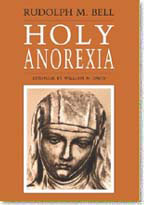 Rudolph M. Bell compares modern descriptions of anorexia nervosa with the recorded behavior of some of the best-known Italian female saints from the thirteenth to fifteenth centuries.
Rudolph M. Bell compares modern descriptions of anorexia nervosa with the recorded behavior of some of the best-known Italian female saints from the thirteenth to fifteenth centuries.
Bell argues that Clare of Assisi, Catherine of Siena, and other holy women were not only victims of a disease, but also in a way victims of a medieval Christian culture which allowed young women no other way to experience the disease’s effects than as symptoms of religious fervor.
Bell’s attitude toward his sources is somewhat biased as he treats his medieval sources as literal truth, sometimes as distorted, agenda-ridden hagiography. They are, undoubtedly, a bit of both. Nonetheless, it is obvious that these holy women were more likely than their male counterparts to practice ascetic – even bizarre – food rituals in lieu or excess of other ascetic behavior.
Bell spends a great more deal of time considering the phenomenon of female fasting in the both its broad medieval and specific Christian contexts. Bell’s argument for a connection between the rise of “holy anorexia” and the development of the mendicant orders is an intriguing bit of historical cause and effect.
Bell, professor of history at Rutgers University, is the author of a number of books in Italian history, among them Fate and Honor, Family and Village: Demographic and Cultural Change in Rural Italy Since 1800, Holy Anorexia, How to Do It: Guides to Good Living for Renaissance Italians, and The Voices of Gemma Galgani: The Life and Afterlife of a Modern Saint (with Cristina Mazzoni), all published by the University of Chicago Press.
Author: Rudolph M. Bell
Year of Release: 1987